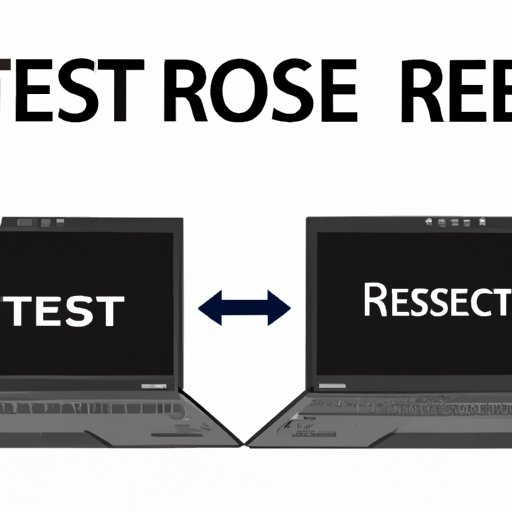
I. Introduction
Resetting your laptop can be a daunting task, but when done correctly, it can solve various problems and improve your device’s performance. In this article, we will guide you on how to factory reset your laptop and highlight its benefits, along with some common issues and alternative methods.
II. Step-by-Step Guide
Before we start, let’s clarify one thing: factory resetting a laptop means erasing everything on it, including personal files, settings, and installed applications. So, before you proceed, make sure to back up any vital information you want to keep.
Most modern laptops come with built-in factory reset options such as System Restore, Reset this PC, or Recovery Partition. However, the process can vary depending on the device and operating system you’re using. Here’s a step-by-step guide on how to factory reset your laptop:
- Click on the Start Menu: If you’re using Windows 10, click on the Start menu and choose “Settings.”
- Choose “Update and Security”: In the Settings window, choose “Update and Security.”
- Select “Recovery”: Once you’re on the Update and Security screen, click “Recovery” on the left-hand side of the window.
- Choose “Get Started”: Under the Reset this PC section on the right-hand side of the window, select “Get Started.”
- Choose an Option: Select whether you want to keep your files or remove everything, then click “Next.”
- Reset: Click “Reset” to begin the reset process.
If your laptop doesn’t have a built-in reset option, you can perform a hard reset by pressing a particular key combination during boot-up. Consult your laptop’s user manual or manufacturer’s website to learn how to do this. Additionally, some laptops may require a recovery disc or USB drive to reset, so make sure to have it on hand.
III. Video Tutorial
Watching a video tutorial can help you understand the process visually and minimize possible errors. Below is a comprehensive video tutorial that covers the factory reset process for Windows 10 laptops:
The video covers the essential steps, including how to back up your files, access the reset option, and select settings. If you encounter any issues, you can pause and rewind the video or consult the written guide in this article.
IV. Common Issues
While performing a factory reset, you might face some issues, such as a frozen screen, unexpected errors, or missing drivers. Here are some solutions to common problems:
- Frozen screen: If your laptop becomes unresponsive during the reset process, force shut it down, then try again.
- Unexpected errors: If the reset process fails and your laptop won’t boot, you may need to reinstall your operating system using a bootable USB drive or a DVD.
- Missing drivers: After the reset, some of your device’s drivers may be missing, causing issues with the hardware. In such cases, visit your laptop manufacturer’s website and download the necessary drivers.
To prevent these issues, make sure to follow the guide and backup your files before resetting your laptop. Additionally, make sure your laptop has enough battery power, or better, connect it to a power source.
V. Benefits of Factory Resetting a Laptop
Resetting your laptop to the factory settings has several benefits:
- Improved speed: Over time, your laptop accumulates software, files, and general clutter. Resetting it can remove the bloatware and improve its performance.
- More storage space: Similarly, by removing unnecessary files and programs, resetting your laptop can free up valuable drive space.
- System stability: Resetting eliminates any software conflicts and adds stability to your laptop.
- Removal of malware and viruses: If your laptop is infected with malware or a virus, a factory reset can remove it entirely.
- Restore to original state: Finally, resetting your laptop will return it to its original state with the default settings and configurations.
Factory resetting is useful in various scenarios, such as if you’re selling your laptop or giving it to someone else. It’s also an effective last-resort option for troubleshooting persistent issues on your device.
VI. Alternative Methods
Aside from the methods mentioned above, there are alternative ways to reset your laptop:
- Recovery discs: Some laptops come with recovery discs that you can use to restore your laptop to its default settings.
- Windows Recovery Environment: If you can’t access the Reset this PC option, you can use Windows Recovery Environment (RE) to reset your laptop.
- Third-party software: There are various third-party software solutions available that can help you reset your laptop, such as CCleaner or PC Decrapifier.
However, note that these methods might differ in terms of effectiveness and outcomes. Additionally, some of them come with additional costs or are more complex to execute.
VII. Tips and Tricks
Here are some tips and tricks that can help you reset your laptop more smoothly:
- Backup your files: As we mentioned earlier, backup your files to an external device or a cloud service before resetting your laptop.
- Save passwords and product keys: Keep a record of your passwords and product keys in a safe place, as resetting means losing all your data.
- Disable antivirus software: Some antivirus software can interfere with the resetting process. So, disable them temporarily before starting the reset process.
- Fully charge your laptop: To avoid any interruptions during the resetting process, make sure your laptop is fully charged or plugged into a power source.
By following these tips, you can avoid unnecessary setbacks and ensure that the process goes smoothly.
VIII. Conclusion
Resetting your laptop can help you solve multiple problems and restore your device’s performance, but it should be done with care and attention. With our step-by-step guide, you’ll be able to reset your laptop smoothly and with confidence. Keep in mind the benefits that resetting can bring, and don’t hesitate to use it whenever necessary.





